Building Java Programs
Lab 3: Ch. 3G: Graphics
Except where otherwise noted, the contents of this document are Copyright 2012 Stuart Reges and Marty Stepp.
lab document created by Marty Stepp and Stuart Reges
Today's lab
Goals for today:
- use the instructor-provided
DrawingPaneland Java'sGraphicsandColorclasses - practice passing parameters in the context of drawing graphics
- Where you see this icon, you can click it to check the problem in Practice-It!

Graphics
Now we'll explore several exercises related to drawing graphics.
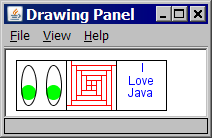
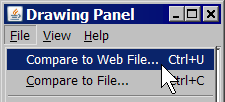
-
We'll use a provided class
DrawingPanelthat works with Java classesGraphics(a "pen" for drawing) andColor. -
Download
DrawingPanel.javato your program directory. -
To check your output in the
DrawingPanel, click File, Compare to URL....
Exercise : Syntax errors
-
The following program contains 12 mistakes! What are they?
Once you think you've found them all, compile/run your corrected code.
1 2 3 4 5 6 7 8 9 10 11 12 13 14
import Java.*; public class PrettyPicture { public static void main(String[] args) { DrawingPanel panel = DrawingPanel(220, 150); setBackgroundColor(Color.YELLOW); Graphics g = panel.Graphics(); panel.setColor(new Color.BLUE); g.drawRectangle(50, 25); g.setColor("RED"); g.fillEllipse(130, 25, 42.1, 40.5); } }
answer on next slide...
Exercise - answer
-
line 1: incorrect
importstatement; should importjava.awt.* -
line 5: missing word
newbefore 2nd occurrence ofDrawingPanel -
line 6: method name should be
setBackground -
line 6: missing
panel.beforesetBackground -
line 8: method name should be
getGraphics -
line 9: the
setColormethod is part of objectg, notpanel -
line 9: should not write
newbeforeColor.BLUE -
line 10: method name should be
drawRect -
line 10: missing two parameters from
drawRect(width and height) -
line 11: color should be specified as
Color.RED, not"RED" -
line 12: method name should be
fillOval - line 12: wrong parameter types; width/height must be integers
Exercise - corrected version
-
Here is a corrected version of the program:
import java.awt.*; public class PrettyPicture { public static void main(String[] args) { DrawingPanel panel = new DrawingPanel(220, 150); panel.setBackground(Color.YELLOW); Graphics g = panel.getGraphics(); g.setColor(Color.BLUE); g.drawRect(50, 25, 10, 10); g.setColor(Color.RED); g.fillOval(130, 25, 42, 40); } }
Exercise : Face

Write a complete Java program that draws the following output:
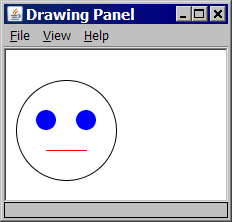
- window size: 220 x 150 px
- overall face circle: 100 px diameter; top-left corner at (10, 30)
- eyes: blue circles, 20 px diameter; top-left at (30, 60) and (70, 60)
- mouth: red line from (40, 100) to (80, 100)
Exercise - answer
import java.awt.*;
public class Face1 {
public static void main(String[] args) {
DrawingPanel panel = new DrawingPanel(220, 150);
Graphics g = panel.getGraphics();
g.drawOval(10, 30, 100, 100); // face outline
g.setColor(Color.BLUE);
g.fillOval(30, 60, 20, 20); // eyes
g.fillOval(70, 60, 20, 20);
g.setColor(Color.RED); // mouth
g.drawLine(40, 100, 80, 100);
}
}
Exercise : Stairs loop table
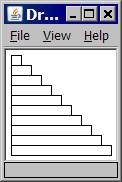
Consider the output at right. The first stair's top-left corner is at position (5, 5). The first stair is 10x10 px in size. Each stair is 10px wider than the one above it.
Fill in the table below with the coordinates and sizes of the first five stairs. Note which values change and which ones stay the same.
| stair | x | y | width | height |
|---|---|---|---|---|
1
|
5 |
5 |
10 |
10 |
2
|
5 |
15 |
20 |
10 |
3
|
5 |
25 |
30 |
10 |
4
|
5 |
35 |
40 |
10 |
5
|
5 |
45 |
50 |
10 |
Exercise : Stairs


Write a complete Java program to draw the stairs. Copy/paste the code template below into jGRASP and fill in your own expressions or values for each stair's x, y, width, and height.
Use your table from the previous slide to help you find the correct expressions.
The values that change for each stair should become expressions in terms of the loop counter variable, i.
import java.awt.*;
public class Stairs1 {
public static void main(String[] args) {
DrawingPanel panel = new DrawingPanel(110, 110);
Graphics g = panel.getGraphics();
for (int i = 0; i < 10; i++) {
g.drawRect(x, y, width, height);
}
}
}
Exercise : Stairs 2

Modify your stairs program to draw one (or all) of the following outputs.
Modify only the body in your for loop.
(You may want to make a new table to find the expressions for x, y, width, and height.)
 →
→
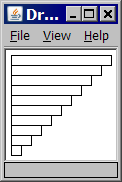
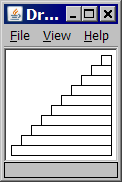
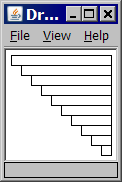
Exercise - answer
To get each output, change the for loop body to the following:
// output 2
g.drawRect(5, 5 + 10*i, 100 - 10*i, 10);
// output 3
g.drawRect(95 - 10*i, 5 + 10*i, 10 + 10*i, 10);
// output 4
g.drawRect(5 + 10*i, 5 + 10*i, 100 - 10*i, 10);
Parameterized methods and Graphics
When you want to divide a graphical program into multiple drawing methods, you must pass Graphics g as a parameter in addition to any other parameters. Example:
public static void main(String[] args) {
DrawingPanel panel = new DrawingPanel(400, 300);
Graphics g = panel.getGraphics();
...
drawStuff(g, 13, 52, 7);
}
public static void drawStuff(Graphics g, int a, int b, int c) {
g.drawLine(a, 45, b, c);
...
}
Exercise : Face 2

Modify your previous Face program to draw the following output.
Write a parameterized method that allows you to draw a face at different positions.

- window size: 320 x 180 px
- faces' top-left corners at (10, 30) and (150, 50)
Exercise - answer
import java.awt.*;
public class Face2 {
public static void main(String[] args) {
DrawingPanel panel = new DrawingPanel(320, 180);
Graphics g = panel.getGraphics();
drawFace(g, 10, 30);
drawFace(g, 150, 50);
}
public static void drawFace(Graphics g, int x, int y) {
g.setColor(Color.BLACK);
g.drawOval(x, y, 100, 100);
g.setColor(Color.BLUE);
g.fillOval(x + 20, y + 30, 20, 20);
g.fillOval(x + 60, y + 30, 20, 20);
g.setColor(Color.RED);
g.drawLine(x + 30, y + 70, x + 70, y + 70);
}
}
Exercise : Face 1+2

Suppose you have an existing program that draws the "face" figure at right. Let's modify the program using methods and parameters so that we can draw several faces at different locations.
continued on the next slide...
Exercise : Face 2

Modify the Face program to draw the following output.
Write a parameterized method that draws a face at different positions.

- window size: 320 x 180 px
- faces' top-left corners at (10, 30) and (150, 50)
Exercise - answer
import java.awt.*;
public class Face2 {
public static void main(String[] args) {
DrawingPanel panel = new DrawingPanel(320, 180);
Graphics g = panel.getGraphics();
drawFace(g, 10, 30);
drawFace(g, 150, 50);
}
public static void drawFace(Graphics g, int x, int y) {
g.setColor(Color.BLACK);
g.drawOval(x, y, 100, 100);
g.setColor(Color.BLUE);
g.fillOval(x + 20, y + 30, 20, 20);
g.fillOval(x + 60, y + 30, 20, 20);
g.setColor(Color.RED);
g.drawLine(x + 30, y + 70, x + 70, y + 70);
}
}
Exercise : Face 3

Modify your previous Java program to draw the following output.
Use a for loop with your parameterized method to draw faces at different positions.
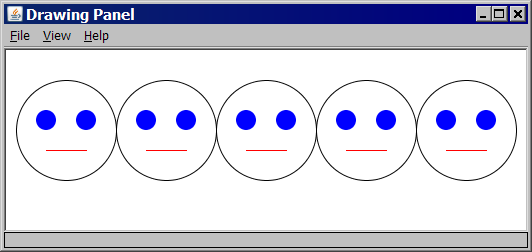
- window size: 520 x 180 px
- faces' top-left at (10, 30), (110, 30), (210, 30), (310, 30), and (410, 30)
Exercise - answer
import java.awt.*;
public class Face3 {
public static void main(String[] args) {
DrawingPanel panel = new DrawingPanel(520, 180);
Graphics g = panel.getGraphics();
for (int i = 0; i < 5; i++) {
drawFace(g, 10 + i * 100, 30);
}
}
public static void drawFace(Graphics g, int x, int y) {
g.setColor(Color.BLACK);
g.drawOval(x, y, 100, 100);
g.setColor(Color.BLUE);
g.fillOval(x + 20, y + 30, 20, 20);
g.fillOval(x + 60, y + 30, 20, 20);
g.setColor(Color.RED);
g.drawLine(x + 30, y + 70, x + 70, y + 70);
}
}
Exercise : Spiral

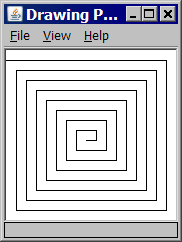
Write a Java program that draws the following output using a for loop.
- window size: 170 x 170 px
- "spiral" lines starting from (0, 10), going right 160, down 150, left 150, up 140, right 140, down 130, left 130, up 120, ...
Exercise - answer
import java.awt.*;
public class Spiral {
public static void main(String[] args) {
DrawingPanel panel = new DrawingPanel(170, 170);
Graphics g = panel.getGraphics();
for (int i = 0; i < 8; i++) {
g.drawLine( 10*i, 10 + 10*i, 160 - 10*i, 10 + 10*i); // top
g.drawLine(160 - 10*i, 10 + 10*i, 160 - 10*i, 160 - 10*i); // right
g.drawLine( 10 + 10*i, 160 - 10*i, 160 - 10*i, 160 - 10*i); // bottom
g.drawLine( 10 + 10*i, 20 + 10*i, 10 + 10*i, 160 - 10*i); // left
}
}
}
Exercise - answer, alternative version
import java.awt.*;
public class Spiral {
public static void main(String[] args) {
DrawingPanel panel = new DrawingPanel(170, 170);
Graphics g = panel.getGraphics();
int x = 0, y = 10;
int len = 160;
for (int i = 0; i < 8; i++) {
g.drawLine(x, y, x + len, y); // right
x = x + len;
len = len - 10;
g.drawLine(x, y, x, y + len); // down
y = y + len;
g.drawLine(x, y, x - len, y); // left
x = x - len;
len = len - 10;
g.drawLine(x, y, x, y - len); // up
y = y - len;
}
}
}
Exercise : Sierpinski Triangle
Write a Java program that draws the following output.... Just kidding!
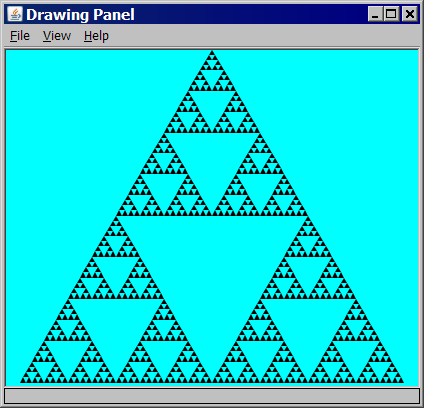
If you finish them all...
If you finish all the exercises, try out our Practice-It web tool. It lets you solve Java problems from our Building Java Programs textbook.
You can view an exercise, type a solution, and submit it to see if you have solved it correctly.
Choose some problems from the book and try to solve them!